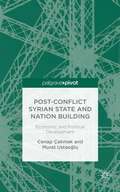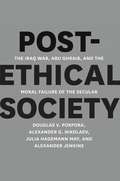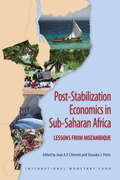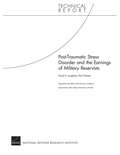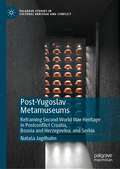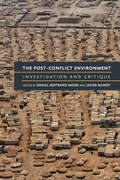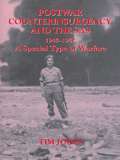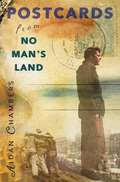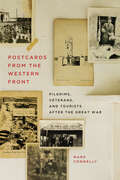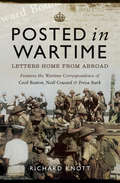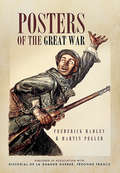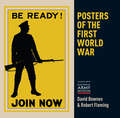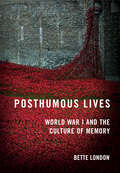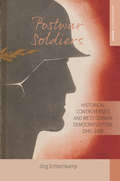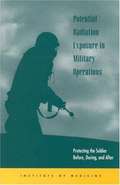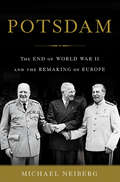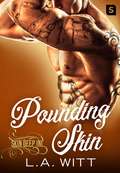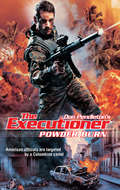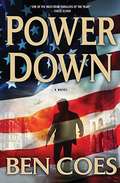- Table View
- List View
Post-Conflict Syrian State and Nation Building: Economic and Political Development
by Cenap Çakmak Murat UstaoğluBased on extensive field work involving the leading figures of the diverse Syrian National Coalition, an umbrella initiative of opposition groups fighting against the Assad regime, this study critically evaluates the challenges ahead as well as the inherent opportunities for the post-conflict era in Syria.
Post-Ethical Society: The Iraq War, Abu Ghraib, and the Moral Failure of the Secular
by Douglas V. Porpora Alexander Nikolaev Julia Hagemann May Alexander JenkinsWeve all seen the images from Abu Ghraib: stress positions, US soldiers kneeling on the heads of prisoners, and dehumanizing pyramids formed from black-hooded bodies. We have watched officials elected to our highest offices defend enhanced interrogation in terms of efficacy and justify drone strikes in terms of retribution and deterrence. But the mainstream secular media rarely addresses the morality of these choices, leaving us to ask individually: Is this right? In this singular examination of the American discourse over war and torture, Douglas V. Porpora, Alexander Nikolaev, Julia Hagemann May, and Alexander Jenkins investigate the opinion pages of American newspapers, television commentary, and online discussion groups to offer the first empirical study of the national conversation about the 2003 invasion of Iraq and the revelations of prisoner abuse at Abu Ghraib a year later. "Post-Ethical Society" is not just another shot fired in the ongoing culture war between conservatives and liberals, but a pensive and ethically engaged reflection of Americas feelings about itself and our actions as a nation. And while many writers and commentators have opined about our moral place in the world, the vast amount of empirical data amassed in "Post-Ethical Society "sets it apart--and makes its findings that much more damning.
Post-Stabilization Economics in Sub-Saharan Africa
by Jean A.P. Clément Shanaka J. PeirisWritten primarily by staff in the African Department of the International Monetary Fund, this volume holds up Mozambique as a model of post-conflict economic growth and poverty reduction. It ascribes Mozamique's success to sound and sustained macroeconomic management, substantial official development assistance, two waves of reforms, and the role of the International Monetary Fund and the World Bank in promoting aid effectiveness. It draws out lessons for the rest of Sub-Saharan Africa in chapters addressing poverty reduction, sustaining economic growth, monetary and financial sector policies, macroeconomic management of scaled-up foreign aid, government-donor coordination, managing mineral resources, strengthening the business environment, and export performance and governance. Annotation ©2008 Book News, Inc. , Portland, OR (booknews. com)
Post-Traumatic Stress Disorder and the Earnings of Military Reservists
by Paul Heaton David S. LoughranAn investigation of the effects of having symptoms of post-traumatic stress disorder (PTSD) on the labor market earnings of reservists in the years following deployment.
Post-Vietnam Dioxin Exposure in Agent Orange-Contaminated C-123 Aircraft
by Committee to Evaluate the Potential Exposure of Agent Orange/TCDD Residue Level of Risk of Adverse Health Effects for Aircrew of Post-Vietnam C-123 AircraftFrom 1972 to 1982, approximately 1,500-2,100 US Air Force Reserve personnel trained and worked on C-123 aircraft that had formerly been used to spray herbicides in Vietnam as part of Operation Ranch Hand. After becoming aware that some of the aircraft on which they had worked had previously served this purpose, some of these AF Reservists applied to the US Department of Veterans Affairs (VA) for compensatory coverage under the Agent Orange Act of 1991. The Act provides health care and disability coverage for health conditions that have been deemed presumptively service-related for herbicide exposure during the Vietnam War. The VA denied the applications on the basis that these veterans were ineligible because as non-Vietnam-era veterans or as Vietnam-era veterans without "boots on the ground" service in Vietnam, they were not covered. However, with the knowledge that some air and wipe samples taken between 1979 and 2009 from some of the C-123s used in Operation Ranch Hand showed the presence of agent orange residues, representatives of the C-123 Veterans Association began a concerted effort to reverse VA's position and obtain coverage. At the request of the VA, "Post-Vietnam Dioxin Exposure in Agent Orange-Contaminated C-123 Aircraft" evaluates whether or not service in these C-123s could have plausibly resulted in exposures detrimental to the health of these Air Force Reservists. The Institute of Medicine assembled an expert committee to address this question qualitatively, but in a scientific and evidence-based fashion. This report evaluates the reliability of the available information for establishing exposure and addresses and places in context whether any documented residues represent potentially harmful exposure by characterizing the amounts available and the degree to which absorption might be expected. "Post-Vietnam Dioxin Exposure" rejects the idea that the dioxin residues detected on interior surfaces of the C-123s were immobile and effectively inaccessible to the Reservists as a source of exposure. Accordingly, this report states with confidence that the Air Force Reservists were exposed when working in the Operation Ranch Hand C-123s and so experienced some increase in their risk of a variety of adverse responses.
Post-Yugoslav Metamuseums: Reframing Second World War Heritage in Postconflict Croatia, Bosnia and Herzegovina, and Serbia (Palgrave Studies in Cultural Heritage and Conflict)
by Nataša JagdhuhnThis book analyzes how Second World War heritage is being reframed in the memorial museums of the post-socialist, post-conflict states of Croatia, Bosnia and Herzegovina, and Serbia. It argues that in all three countries, a reluctance to confront undesirable parts of their national histories is the root cause explaining why the state-funded Second World War memorial museums remain stuck in the postsocialist transition. In most cases, Second World War museums, exhibitions, and displays conceived in the Yugoslav period have been left unchanged. However, there are also examples where new sections were added to the old ones and there are a small number of completely reconceptualized permanent exhibitions. The transitional position of the Second World War museums has made it possible to view these institutions as historical formations in their own right. The book will appeal to students and academics working in the fields of heritage and museums studies, memory studies, and cultural history of Southeast-Europe.
Post-conflict Environment: Investigation And Critique
by Daniel Bertrand MonkIn case studies focusing on contemporary crises spanning Africa, the Middle East, and Eastern Europe, the scholars in this volume examine the dominant prescriptive practices of late neoliberal post-conflict interventions--such as statebuilding, peacebuilding, transitional justice, refugee management, reconstruction, and redevelopment--and contend that the post-conflict environment is in fact created and sustained by this international technocratic paradigm of peacebuilding. Key international stakeholders--from activists to politicians, humanitarian agencies to financial institutions--characterize disparate sites as "weak," "fragile," or "failed" states and, as a result, prescribe peacebuilding techniques that paradoxically disable effective management of post-conflict spaces while perpetuating neoliberal political and economic conditions. Treating all efforts to represent post-conflict environments as problematic, the goal becomes understanding the underlying connection between post-conflict conditions and the actions and interventions of peacebuilding technocracies.
Post-war Counterinsurgency and the SAS, 1945-1952: A Special Type of Warfare (Military History and Policy)
by Tim JonesThis work details the state of British counterinsurgency knowledge by 1945, and shows how wartime special forces and unconventional warfare affected many postwar counterinsurgencies. The vital role of the Special Air Service (SAS) is revealed here for the first time.
Postales del Este
by Reyes MonforteUna emocionante historia basada en hechos reales sobre la memoria, el amor y la esperanza en medio del horror de Auschwitz. En septiembre de 1943, la joven Ella llega prisionera al campo de concentración de Auschwitz, desde Francia. La jefa del campo de mujeres, la sanguinaria SS María Mandel, apodada la Bestia, descubre que su caligrafía es perfecta y la incorpora como copista en la Orquesta de Mujeres. Gracias a su conocimiento de idiomas, Ella comienza a trabajar en el Bloque Kanadá donde encuentra numerosas postales y fotografías en los equipajes de los deportados, y decide escribir en ellas sus historias para que nadie olvide quiénes fueron. Mientras forma lazos de amistad con las presas, sobrevive a la maldad de sus captores y evita que descubran su particular resistencia hecha a golpe de palabras, una rebelión se gesta entre los presos que amenaza aún más su vida y la del hombre que ama, Joska. Casi cuarenta años después, la joven Bella recibe una caja llena de postales. «Son postales que tu madre escribió cuando estuvo en el Este. Así las llamó: Postales del Este. Ella quería que las leyeras a su debido tiempo. Y ese tiempo es ahora.» Combinando ficción con personajes históricos como Josef Mengele, Heinrich Himmler, Irma Grese, Rudolf Hoss, Ana Frank o Alma Rosé, Reyes Monforte regresa al género que le ha consagrado como autora. Ricamente documentada y escrita con pasión y emotividad, ha firmado su obra más ambiciosa: una historia sobre el poder liberador de las palabras, en el 75 aniversario de la liberación del campo de concentración de Auschwitz.
Postcards From No Man's Land
by Aidan ChambersSeventeen-year-old Jacob Todd is about to discover himself. Jacob's plan is to go to Amsterdam to honor his grandfather who died during World War II. He expects to go, set flowers on his grandfather's tombstone, and explore the city. But nothing goes as planned. Jacob isn't prepared for love&150or to face questions about his sexuality. Most of all, he isn't prepared to hear what Geertrui, the woman who nursed his grandfather during the war, has to say about their relationship. Geertrui was always known as Jacob's grandfather's kind and generous nurse. But it seems that in the midst of terrible danger, Geertrui and Jacob's grandfather's time together blossomed into something more than a girl caring for a wounded soldier. And like Jacob, Geertrui was not prepared. Geertrui and Jacob live worlds apart, but their voices blend together to tell one story&150a story that transcends time and place and war. By turns moving, vulnerable, and thrilling, this extraordinary novel takes the reader on a memorable voyage of discovery.
Postcards from the Western Front: Pilgrims, Veterans, and Tourists after the Great War (Human Dimensions in Foreign Policy, Military Studies, and Security Studies)
by Mark ConnellyVisitors to the battlefields of France and Belgium expressed pain and anguish, pride and nostalgia, and wonder and surprise at what they saw. Postcards from the Western Front chronicles the many ways in which these sites were perceived and commemorated by British people, both during the First World War and in the twenty years following the Armistice.Mark Connelly’s definitive and engaging study of the former Western Front examines how different and distinctive sub-communities – regional, ethnic and religious, civilian and armed forces – influenced the depth and strength of the visiting public’s relationship with the battlefields, all the while comparing and contrasting this relationship with the viewpoint of the French and Belgian inhabitants of the devastated regions. Connelly draws from a vast archive a number of interlocking themes, including the lingering presence of the battlefields in the British domestic imagination, the often fraught experience of visiting the battlefields, memorials and cemeteries functioning as part of a historical testimony to wartime realities, and the interactions between visitors and the people living in these former fighting zones. Focusing on French and Belgian sites, Connelly nevertheless provides insight into other major battlefields fought over by troops from the British Empire. Extensively illustrated with black and white photographs, Postcards from the Western Front offers a groundbreaking perspective on landscapes that rarely left anyone – whether tourist, inhabitant, veteran, or pilgrim – unmoved.
Posted in Wartime: Letters Home From Abroad
by Richard KnottThe Second World War saw many people consigned to long periods of exile, far from home. How did the exiled keep in touch with home? Why were some exiles silent when others wrote frequently and at length? Posted in Wartime explores the nature of such exile and considers what could be written in diaries and letters, given that letters were censored and diaries were, at best, frowned upon. At the books heart are the stories of three very different exiles: a Liberty Ship captain; a doctor in the Royal Army Medical Corps; and an airman in Iraq and Palestine. Set alongside those are the experiences of a number of celebrated wartime exiles whose diaries and letters are both extensive and detailed, and whose stories loosely connect with the journeys of the three main protagonists; they include the travel writer Freya Stark, the photographer Cecil Beaton, and the playwright Nol Coward.* Exhibition of Cecil Beaton photography (of the Duchess of Devonshire and her set) at Chatsworth, March 2016 to January 2017.* The reopening of the British Postal Museum & Archive as The Postal Museum in London in 2017* 100th anniversary of the Imperial War Museum, London, 2017*75 years since the release of Noel Cowards film about the Navy at war, In Which We Serve (1942)* 75 years (on 15 April) since the authors father sailed to the Middle East in Winston Special convoy WS18* 100 years (in November 2017) since the Balfour Declaration (Middle East)* 70 years since Indian independence.
Posters of The Great War: Published in Association with Historical le Grande Guerre, Peronne, France
by Martin Pegler Frédérick HadleyUntil the arrival of radio and television, and despite the influence of newspapers, posters were the major medium for mass communication. During the Great War all the belligerent nations produced an extraordinary variety of them - and they did so on a massive scale. As the 200 wartime and immediate post-war posters selected for this book reveal, they were one of the most potent, and memorable, ways of conveying news, information and propaganda. In the most graphic and colourful fashion they promoted values such as patriotism and sacrifice. By using rallying symbols such as flags as well as historical and mythical models, they sought to maintain morale and draw people together by stirring up anger against the enemy. Today their remarkable variety of styles give us an instant insight into the themes and messages the military and civilian authorities wished to publicize.The sheer inventiveness of the poster artists is demonstrated as they focused on key aspects of the propaganda campaign in Britain, France, Germany, America and Russia. The diversity of their work is displayed here in chapters that cover recruitment, money raising, the soldier, the enemy, the family and the home front, films and the post-war world. A century ago, when these images were first viewed, they must have been even more striking in contrast to the poor-quality newspaper photographs and postcards that were available at the time. The Great War was to change that forever. It introduced a means of propaganda that was novel, persuasive and above all, powerful. It was the first media war, and the poster played a key role in it.
Posters of the First World War
by Robert FlemingThe First World War, a new low in the annals of armed conflict, coincided with a golden age for the relatively new art of advertising. Striking and colourful posters were produced throughout the years 1914-18 to recruit soldiers, promote investment, keep up morale and, naturally, to vilify the enemy; prominent artists including Alfred Leete paired bold images with punchy text to maximise impact. The selection in this book offers an informative guide to the range of posters created and to how they were displayed around the nation, and explores the public's increasing dissatisfaction with being patronised and goaded. From the iconic, commanding Your Country Needs YOU! to the anxious domestic scene of Daddy, What Did YOU Do in the War?, and including the infamous depiction of a bayoneting in Back Him Up!, this book puts the reader in the shoes of the Great War 'man in the street'.
Posthumous Lives: World War I and the Culture of Memory
by Bette LondonPosthumous Lives explores the shifting significance of public and private efforts to commemorate British soldiers killed in World War I—as well as the less well-remembered casualties of the war, including Voluntary Aid Detachments, nurses, conscientious objectors, civilians, and soldiers executed for desertion or cowardice—and the compelling hold the First World War has had on the British imagination for more than a century. By using the concept of the posthumous life—the attempt to extend the presence of the dead into the lives of the living—Bette London demonstrates how this idea came to shape Britain's First World War memory practices and rituals.London draws on a diverse range of source materials—from sentimental memorabilia books commissioned by bereaved families and canonical works of literature and art by Virginia Woolf, Wilfred Owen, and Sir Edwin Lutyens to centenary memorials and commemorative art installations—to uncover the surprising connections between memorialization practices, war writing, and modernism. Spanning the century from the middle of World War I to its centenary celebrations, Posthumous Lives illuminates, in a deeply moving narrative, how the dead are remembered to meet the shifting needs of the living.
Posttraumatic Stress Disorder and Related Diseases in Combat Veterans
by Elspeth Cameron RitchieThis book takes a case-based approach to addressing the challenges psychiatrists and other clinicians face when working with American combat veterans after their return from a war zone. Written by experts, the book concentrates on a wide variety of concerns associated with posttraumatic stress disorder (PTSD), including different treatments of PTSD. The text also looks at PTSD comorbidities, such as depression and traumatic brain injury (TBI) and other conditions masquerading as PTSD. Finally, the authors touch on other subjects concerning returning veterans, including pain, disability, facing the end of a career, sleep problems , suicidal thoughts, violence, , and mefloquine "toxidrome". Each case study includes a case presentation, diagnosis and assessment, treatment and management, outcome and case resolution, and clinical pearls and pitfalls. Post-Traumatic Stress Disorder and Related Diseases in Combat Veterans is a valuable resource for civilian and military mental health practitioners, and primary care physicians on how to treat patients returning from active war zones.
Postwar Migration Policy and the Displaced of the British Zone in Germany, 1945–1951: Fighting for a Future (Palgrave Studies in Migration History)
by Imogen BayleyThis book examines the experiences of refugees who populated the Displaced Persons (DP) camps in the British Zone of Allied-occupied Germany after the Second World War. With a specific focus on Polish and Jewish communities, it explores the interaction between migration policy and the migration strategy of refugees - or in other words – the relationship between DP policy and individual choices, and how these evolved over time. The book aims to harmonize often contradictory images of displaced persons in the British Zone of occupation by taking a comparative approach and analysing conflicting identifications and state-individual relations. Drawing on the records of the International Tracing Service, refugee memoirs, DP publications distributed in the camps themselves, and personal petitions and correspondences, the author sheds light on the experiences of displaced persons and illustrates the difficulty of making clear-cut distinctions between forced and voluntary migration. Today, as in the post-war period, refugees’ access to social rights and welfare, settlement rights, and the possibility of family reunification, can all be determined by the same labels that were so fiercely contested after 1945. A dichotomy between so-called ‘economic’ and ‘political’ migration endures, and many claims to asylum are today rejected on the grounds of applicants not being formally recognized as ‘genuine’ refugees and recipients of aid. This book therefore adds to our growing understanding of the plight of refugees and the need to ensure access to justice for all through the ongoing building of an effective, accountable, and inclusive refugee regime.
Postwar Soldiers: Historical Controversies and West German Democratization, 1945–1955 (Making Sense of History #39)
by Jörg EchternkampContemporary historians have transformed our understanding of the German military in World War II, debunking the “clean Wehrmacht” myth that held most soldiers innocent of wartime atrocities. Considerably less attention has been paid to those soldiers at the end of hostilities. In Postwar Soldiers, Jörg Echternkamp analyzes three themes in the early history of West Germany: interpretations of the war during its conclusion and the occupation period; military veteran communities’ self-perceptions; and the public rehabilitation of the image of the German soldier. As Echternkamp shows, public controversies around these topics helped to drive the social processes that legitimized the democratic postwar order.
Potential Radiation Exposure in Military Operations: Protecting the Soldier Before, During, and After
by Institute of MedicineThe Committee's final report, reiterating technical aspects addressed in a 1997 interim report, and putting the research findings in an ethical context. The report focuses on the potential exposure of military personnel to radiation doses up to 700 millisievert, examining dosimetry, radiation physics, and the medical follow-up of potential subsequent tumor development. There is no index. Annotation c. Book News, Inc. , Portland, OR (booknews. com)
Potsdam: The End of World War II and the Remaking of Europe
by Michael NeibergAfter Germany’s defeat in World War II, Europe lay in tatters. Millions of refugees were dispersed across the continent. Food and fuel were scarce. Britain was bankrupt, while Germany had been reduced to rubble. In July of 1945, Harry Truman, Winston Churchill, and Joseph Stalin gathered in a quiet suburb of Berlin to negotiate a lasting peace: a peace that would finally put an end to the conflagration that had started in 1914, a peace under which Europe could be rebuilt. The award-winning historian Michael Neiberg brings the turbulent Potsdam conference to life, vividly capturing the delegates’ personalities: Truman, trying to escape from the shadow of Franklin Roosevelt, who had died only months before; Churchill, bombastic and seemingly out of touch; Stalin, cunning and meticulous. For the first week, negotiations progressed relatively smoothly. But when the delegates took a recess for the British elections, Churchill was replaced--both as prime minster and as Britain’s representative at the conference--in an unforeseen upset by Clement Attlee, a man Churchill disparagingly described as "a sheep in sheep’s clothing. ” When the conference reconvened, the power dynamic had shifted dramatically, and the delegates struggled to find a new balance. Stalin took advantage of his strong position to demand control of Eastern Europe as recompense for the suffering experienced by the Soviet people and armies. The final resolutions of the Potsdam Conference, notably the division of Germany and the Soviet annexation of Poland, reflected the uneasy geopolitical equilibrium between East and West that would come to dominate the twentieth century. As Neiberg expertly shows, the delegates arrived at Potsdam determined to learn from the mistakes their predecessors made in the Treaty of Versailles. But, riven by tensions and dramatic debates over how to end the most recent war, they only dimly understood that their discussions of peace were giving birth to a new global conflict.
Potter's Raid through South Carolina: The Final Days of the Confederacy (Civil War Series)
by Tom ElmoreIn April 1865, Richmond had fallen, and the Confederacy was dying. Robert E. Lee had surrendered his army to Ulysses S. Grant in Virginia. Joseph Johnston was in North Carolina negotiating the surrender of his army to William T. Sherman. But in South Carolina, General Edward Potter was leading 2,500 Union soldiers, including the famed African American regiment the Fifty-fourth Massachusetts, through the state's interior, intent on destroying the railroads and equipment. This is the story of Potter's Raid. Using rare and nearly forgotten accounts, historian Tom Elmore has compiled the story of this often-overlooked campaign that featured the last shots of the Civil War in the state that started it.
Pounding Skin (Skin Deep Inc. #2)
by L. A. WittA Skin Deep, Inc. NovelFighter pilot Jon Russell never sleeps with the same man twice. Known for his lack of shame when it comes to hooking up, Jon has no interest in commitment—even friends with benefits sounds like too much work. Matt Huffman has slept with lots of women. He’s had loads of girlfriends. So why does the hot as hell pilot getting a tattoo as the result of a lost bet stop his breath? And how come he can’t stop thinking about him, even after he’s gone?When Jon returns to Skin Deep the second time, he doesn’t want another tattoo. He wants to hook up with the gorgeous artist he spent hours agonizingly close to, and Matt wants to explore some curiosity about men. Fulfill the desire he can’t stop fantasizing over. And he wants to do it with Jon.As their casual hook up becomes more than just skin deep, both Matt and Jon are faced with questions they don’t want to answer. Matt understands he’s bi—but are these feelings he has typical of hooking up with a man? Or is it only Jon that can make his heart pound? If Jon wanted nothing more than a fling, why does he find himself needing not just Matt’s body, but all of him? And can their relationship withstand the hardships that makes Jon avoid them in the first place?Pounding Skin is part of the Skin Deep, Inc series. The Skin Deep, Inc books can be read in any order—come enter a world where gorgeous tattoo artists and hot Navy men find passion, pleasure, and a happily ever after together.L.A. Witt also writes under the name Lauren Gallagher.
Powder Burn
by Don PendletonA ruthless Colombian drug lord has launched a deadly campaign targeting DEA agents and U. S. diplomats. With the body count growing and the American government powerless, Mack Bolan is called in as a last resort to infiltrate the criminal syndicate and destroy the chain of command before more innocent blood is shed. As the number of attacks grows, Bolan knows he must shut down the operation quickly. But the cartel's ruthless expansion plan is well under way, and surrendering is not an option. Backed up by a group of right-wing terrorists, the cartel's leader has declared war on any organization-or man-that stands in his way. There's just one flaw in the plan. . . no one expected the Executioner.
Power Down
by Ben CoesIntroducing a major new thriller writer--in the vein of Vince Flynn and Brad Thor--and an electrifying character, Dewey Andreas A major North American hydroelectric dam is blown up and the largest off-shore oil field in this hemisphere is destroyed in a brutal, coordinated terrorist attack. But there was one factor that the terrorists didn't take into account when they struck the Capitana platform off the coast of Colombia--slaughtering much of the crew and blowing up the platform--and that was the Capitana crew chief Dewey Andreas. Dewey, former Army Ranger and Delta, survives the attack, rescuing as many of his men as possible. But the battle has just begun. While the intelligence and law enforcement agencies scramble to untangle these events and find the people responsible, the mysterious figure of Alexander Fortuna--an agent embedded into the highest levels of American society and business--sets into play the second stage of these long-planned attacks. The only fly in the ointment is Dewey Andreas--who is using all his long-dormant skills to fight his way off the platform, then out of Colombia and back to the U.S., following the trail of terrorists and operatives sent to stop him. Power Down is a gripping, compelling debut thriller from a powerful new author, an amazing talent certain to join the ranks of the genre's finest writers.
Power Play
by Patrick RobinsonIt is the year 2018—a highly volatile nuclear world. Israel has obliterated the deep underground nuclear weapons facility built by Iran. The United States has destroyed the nuclear facility of a defiant North Korea. Against this background, the Russians have upped the stakes in the latest world power-play—cyber warfare—to reduce the United States to helplessness: a three-strike missile attack on the National Security Agency at Fort Mead, Maryland, while simultaneously jamming the top-secret electronic access key to America’s nuclear launch system—the nuclear football. If successful, Russia would blow the United States off the nuclear map. Meanwhile the British Royal Navy, formerly the most powerful in the world, is rapidly crumbling, leaving the United States without its main deep sea ally at a time when they’re needed most. As this geo-political battle comes to light behind close doors dealings and dark secrets, it is up to Mossad spymaster, codenamed the ‘Golan,’ to avert the Russian scheme, and there is only one man he in turn can trust to get the job done: US Navy Seal Mack Bedford. It is now up to Mack Bedford, the hero previously encountered in The Delta Solution , Intercept , and Diamondhead , to devise a plan to stop the Russians before they and their cyber weaponry reach the Chinese border—the launch site of their master plan. And with the entire country’s fate in his hands, Mack and his hard-trained, one of a kind SEAL Team 10 must not, cannot fail.
